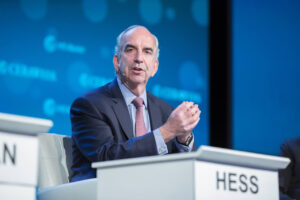- M&A
- November 3, 2023
- 7 minutes read
What’s Chevron After In Oil And Gas Rival Hess Corp?
In late October, oil and gas giant Chevron Corporation (NYSE: CVX) struck a deal to acquire rival Hess Corporation (NYSE:…

In late October, oil and gas giant Chevron Corporation (NYSE: CVX) struck a deal to acquire rival Hess Corporation (NYSE: HES) for $53bn in shares. This deal came barely two weeks after Exxon Mobil (NYSE: XOM), another American oil and gas giant, agreed to buy gas rival Pioneer Natural Resources (NYSE: PXM) for $60bn in shares.
Chevron’s deal to acquire Hess points at the American oil industry trending toward consolidation after making record profits in 2022. We previously explained the rationale behind Exxon’s Pioneer acquisition. Now, it’s time to examine why Chevron is spending nearly 20% of its market value to buy Hess.
Why Is Chevron Buying Hess Corp?
Don’t look far for the answer. It is Guyana, a small South American country with less than a million residents. Guyana struck black gold after a foreign consortium discovered massive oil and gas reserves on its coast in 2015. This consortium comprises Exxon Mobil, Hess Corp, and the China National Offshore Oil Corporation (CNOOC).
These three companies control the Stabroek Block, a 6.6-million-acre offshore field with over 11 billion barrels of recoverable oil and gas discovered so far. Guyana is the prized location for American oil giants to expand as domestic regulations sour on fossil fuel production in favor of cleaner, renewable energy sources.
Exxon holds a 45% stake in the Stabroek Block, Hess holds 30%, and CNOOC owns 25%. Chevron doesn’t want to be left out of this massive oil discovery and needs a way to share in the spoils. It can’t acquire Exxon because this rival has a significantly higher market value, and antitrust regulators will scuttle a merger agreement before it even starts. Chevron can’t buy CNOOC because it’s owned by the Chinese government. Hess is the last option it can afford, and it picked this choice.
Buying Hess will give Chevron a prized stake in Guyana’s oil and gas fields alongside substantial assets in the United States. The deal is expected to close in the first half of 2024.
The acquisition will also end the Hess family oil dynasty formed when the late Leon Hess built his first refinery in the 1950s. Leon’s son, John Hess, is the eponymous company’s chief executive. The Hess dynasty controls about 10% of the company’s shares, meaning a $5bn+ windfall from selling to Exxon.


Buying Hess will give Chevron a prized stake in Guyana’s oil and gas fields alongside substantial assets in the United States. The deal is expected to close in the first half of 2024.
What’s In It For Guyana?

Guyana is a small country on South America’s North Atlantic coast with just around 800,000 inhabitants. It’s a dense country, with 90% of the population living on 10% of the land mass. Trees and forests cover the rest of the land.
Guyana is historically a poor country. Although it has improved substantially over the past two decades, the poverty rate hovered at nearly 50% by 2019, according to the World Bank. Exxon Mobil first discovered oil in Guyana in 2015, and many more fields were found soon after. It has invested billions of dollars in drilling infrastructure alongside Hess and CNOOC, and Guyana has opened bidding for interested companies to develop more oil and gas blocks.
Some have criticized the Exxon-led consortium’s agreement with the Guyanese government for being substantially in the consortium’s favor. The deal allows the consortium to keep 75% of oil sales as production expenses, 12.5% as profit, and the remaining 12.5% for the government. The consortium will also pay 2% of gross sales as royalties out of its share of profits, leaving it with 10.5% and the Guyanese government with 14.5%.
The Guyanese government earned $1.3bn in oil revenues in 2022 and is projected to earn $1.6bn this year. Revenues are projected to top $7.5bn by 2040. If managed well, Guyana could use its oil fortunes to pull its population out of poverty. Some say it could become the richest nation per capita because of its oil wealth.
However, there’s a big issue given that many countries fall victim to the “resource curse,” wherein too much of their capital and labor are concentrated in one sector, and the rest of the economy suffers, leading to worse development outcomes than countries with little to no natural resources. Corruption could also cause oil riches to be concentrated in the hands of a few instead of benefiting the masses.
Fortunately, the Guyanese government is taking steps to avoid falling into the curse. It set up a sovereign wealth fund in 2021 to hold its oil royalties, some of which go into the operating government budget. Oil royalties funded 30% of Guyana’s allocated $3.75bn budget for 2023.

However, Guyana ranks relatively high on the corruption perceptions index: 85 out of 180 countries in 2022. Corruption, both real and perceived, hinders a country’s progress. Guyana’s progress hinges on a competent and disciplined public sector to manage its newly-found oil riches. If managed well, the country could become one of the biggest success stories of the 21st Century.
In the meantime, Guyana is open to oil and gas production deals at more favorable terms than what it got from the Exxon-led consortium. Thanks to massive proven oil reserves, the government is now in a better position to request such terms.
Chevron will play a significant role in Guyana’s future prospects after acquiring Hess. The acquisition gives it ample room to expand after posting a record $35bn in profit on $236bn in sales in 2022. Hess posted a $2.1bn net profit on $11.6bn in revenue in the same year.






